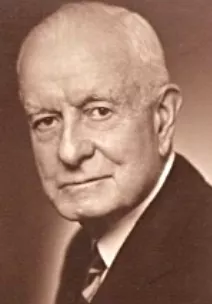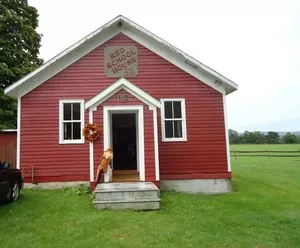Thomas J. Watson, Sr., the founder of the IBM Corporation, spent his boyhood in this valley, playing in the fields, woods and streams that surrounded his parents' farm. After a fire destroyed the farmhouse in which he was born in 1874, Mr. Watson had a replica built on the site of the original. This white house on Dry Run Road sits behind a picket fence on the approach to the Lodge. Near the home is the Red Schoolhouse, the one-room school operational from 1839 to 1957, which Watson attended as a child. In 2001, the Schoolhouse was placed on the National Register of Historic Places.
Throughout his career in business and even after he became the leader of an international corporation, Thomas Watson returned to his childhood home to renew his strength and regain perspective. Near the end of his life, Mr. Watson expressed his wish to develop the land that had meant so much to him into a retreat center for non-profit groups. In August of 1955, with the help of their attorney, Mr. and Mrs. Watson drew up a "Declaration of Trust" to transfer the Homestead deed to the former Genesee Conference of the Methodist Church (later the Western New York Conference of the United Methodist Church). In addition, Mr. Watson donated nearly $1 million in cash and stocks for the purpose of constructing the retreat center buildings.
The gift was made as a memorial to Watson's parents, Thomas and Jane Watson, and was to be known as the Watson Homestead Memorial Foundation. Its purpose was to maintain the Watson Homestead at Coopers Plains, NY, make capital improvements, and to provide for a religious scholarship fund for deserving students entering religious work. Additionally it was to give assistance and benefit to people of all faiths and denominations. Specific goals for the Homestead were also articulated including: a recreation center and summer camp for young people, a place of relaxation and convalescence for pastors, a meeting place for affiliate boards and groups of the United Methodist Church, and a general place of assembly for religious, social service, and community organizations for personal, spiritual and educational enrichment.
The original Watson farm was about 100 acres. Prior to the building of the Lodge, three adjoining farms in the valley were added to the Homestead. Later, two other parcels of land were added, making a current total of approximately 375 acres. The sweep of the valley and the magnificent hills that enclose its beauty form the panoramic view that can be seen from the picture windows of the Lodge. Hiking trails through white pine, maple, and hemlock forests are popular throughout the year and are used as cross-country ski trails in winter. In addition, a visit to our "waterfall" (actually a hanging valley) yields a breathtaking vista on the property.
The first facilities constructed were the Lodge and Cabin area, dedicated on June 30, 1957. Unfortunately, Mr. Watson was unable to see his dream come true, he died in 1956, less than a year after establishing his vision. He was, however, personally involved in the architecture of the Lodge, especially its size, the western cedar woodwork, and the graceful laminated wood arches.
Four Retreat Centers were added to the campus in the mid-1960s. Meanwhile, church groups using the facility expressed need for an adequate chapel. The Jeannette K. Watson Chapel was dedicated in January of 1966. Named in memory of Thomas Watson's wife, the structure was built to reflect the rugged terrain on which the Homestead is located. This addition to the north end of the Lodge also provided a large recreation hall, a library, and flexible spaces for multiple program use.
In 1981, a staff house was remodeled to become Hillside House accommodating sixteen. Retreat Hall, a multi-purpose meeting facility, was constructed in 1985. In 1990, the West Wing was constructed adjacent to the south end of the Lodge. These 27 motel-style rooms with private baths were created in answer to requests for more comfortable adult housing. Since 2001, new additions to the campus include an arts and crafts center, a 36' vertical climbing tower, a seven-circuit stone labyrinth, and a maple sugaring operation. These elements reflect an expanded focus on programmatic and recreational opportunities available for our guests. Elderhostel programs (now called Road Scholar) began in 1982.
From the beginning, Thomas Watson dreamed of a center that would serve a wide spectrum of religious, educational, and service organizations. Over the past decade, the Homestead has served approximately 300 groups per year of all sizes and types, some 11,000 guests annually. The Center is open year-round.
In 2006, WHC&RC became independent of the Methodist Church with its own not-for-profit 501(c)3 designation. It is governed with an independent Board of Directors. Its mission statement declares Watson Homestead provides lodging, facilities and program for those seeking educational enrichment, relaxation and spiritual renewal. We welcome all people to our serene setting with gracious hospitality.
In 2022, the YMCA of Greater Rochester acquired the property, and the name changed from Watson Homestead to The Y at Watson Woods. You can read full details about the acquisition here.

